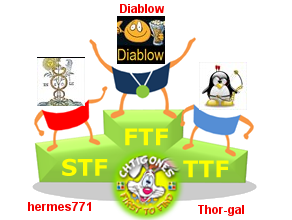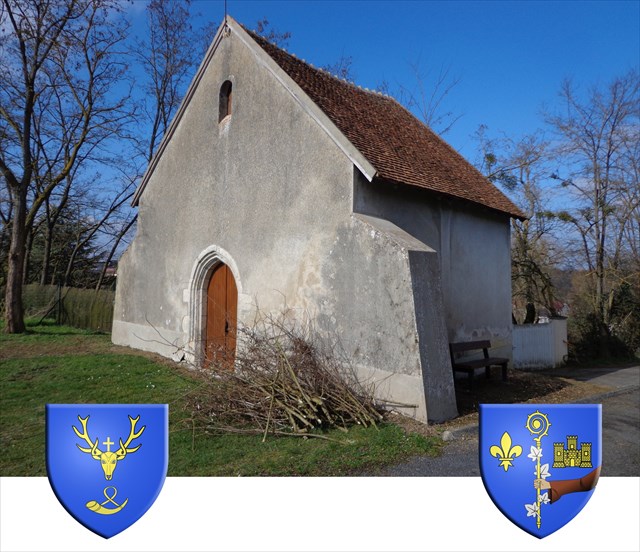Saint-Hubert : conVERTi grâce à un cerf Traditional Cache
Chtigones: La boîte a effectivement disparu.
Comme je ne serai plus en mesure d'assurer des maintenances régulières d'ici quelques mois, je préfère ne pas remettre de boîte et archiver la cache.
L'emplacement est libre pour un nouveau poseur et je tiens les éléments du descriptif à sa disposition s'il le souhaite.
FIN DE PARTIE APRES 9 ANS 1/2 DE BONS ET LOYAUX SERVICES
Saint-Hubert : conVERTi grâce à un cerf
-
Difficulty:
-

-
Terrain:
-

Size:  (small)
(small)
Please note Use of geocaching.com services is subject to the terms and conditions
in our disclaimer.
[FR] Au VIIème siècle, suite à l'apparition d'un cerf portant une croix entre ses bois, Hubert entama une vie monastique exemplaire. A Châtillon-sur-Loire, une petite chapelle lui est consacrée.
[EN] In the VIIth century, further to the appearance of a deer carrying a cross between his wood, Hubert begun an exemplary monastic life. In Châtillon-sur-Loire, a small chapel is dedicated to him.

------------oOo------------

Hubert est né vers le milieu du 7ème siècle. Il était le fils d’un duc d’Aquitaine et descendant des rois mérovingiens. On le dit apparenté à Charles Martel. Il a épousé Floribanne, fille du Roi Dagobert.
Plutôt connu pour ses excès en tous genres, alors qu’il se trouvait engagé dans une chasse dans une partie reculée de la forêt des Ardennes, un cerf, qui paraissait plus grand et plus beau que les autres, lui apparut avec une croix entre ses bois.
Dès lors, il mena une vie monastique exemplaire. Il était le père des pauvres et des orphelins, le soutien des veuves, l’appui des opprimés. Son zèle pour instruire son peuple était infatigable.
Lorsque, vers l’an 720, saint Hubert fit transporter le corps de saint Lambert au village de Liège, où ce saint avait été martyrisé, il y transféra également, avec l’approbation du Pape, le siège de l’évêché, et jeta les fondements de la future ville de Liège (Belgique). Depuis ce temps, cette ville a toujours honoré saint Hubert comme son premier évêque et comme son principal patron.
L’épisode du cerf le désigna tout naturellement comme le patron de tous les chasseurs.
Il mourut en l’an 727 des suites d’un écrasement de la main gauche occasionné par un ouvrier maladroit. Sa fête est célébrée le 3 novembre de chaque année.
A Châtillon-sur-Loire, la chapelle Saint-Hubert se trouve au-dessus du quartier de Nancray et de la vallée de l’Ethelin.
Construite en pierre et couverte de petites tuiles de pays, cette minuscule chapelle comporte un portail daté du XIVe siècle.
A l’intérieur, les murs blancs et le mobilier dépouillé sont d’une grande sobriété. Un bénitier a été placé à l’entrée. Les bancs de bois peuvent accueillir une cinquantaine de personnes. Au-dessus de l’autel, un vitrail est enchâssé dans une fenêtre de pierre du XVIe siècle. Cette œuvre attribuée à Charles Lorin, maître verrier de Chartres, représente le miracle de Saint-Hubert.
La chapelle est actuellement fermée.
La cache finale est une boîte d'environ 6 x 9 cm qui permet la dépose et l'échange d'objets.
Suivant le thème/challenge des caches "VERTes", le dépôt d'objets exclusivement "VERTs" sera apprécié.
-----------------------------
English Version
-----------------------------
[EN]
Hubert was born by the middle of the 7th century. He was the son of a duke of Aquitaine and a descendant of Merovingian kings. We say it related to Charles Martel. He married Floribanne, girl of King Dagobert.
Rather known for his excesses in any kind, while he was committed in a hunting in a party in the forest of the Ardennes, a deer, which seemed bigger and more beautiful than the others, appeared to him with a cross between his wood.
From then on, he lived an exemplary monastic life. He was the father of poor people and orphans, support of the widows, support of the oppressed. His zeal to educate his People was tireless.
When, about in the year 720, saint Hubert made transport saint Lambert's body in the village of Liège, where this saint had been tortured, he also transferred it, with the approval of the Pope, the bishop's head quarter, and cast the foundations of the future city of Liège (Belgium). Since this period, this city always honored saint Hubert as his first bishop and as his patron.
The episode of the deer indicated him quite naturally as the patron of all the hunters.
He died in the year 727 of the suites of a destruction of the left hand caused by a clumsy worker. He is celebrated every November 3rd.
In Châtillon-sur-Loire, the chapel Saint Hubert is over the district of Nancray and the valley of Ethelin.
Built in stone and covered with small tiles of country, this tiny chapel contains a portal dated from the XIVth century.
Inside, the white walls and the bare furniture are very sober. A font was placed in the entrance. Wooden benches can welcome about fifty persons. Over the altar, a stained-glass window is set in a stony window of the XVIth century. This work attributed to Charles Lorin, master glazier of Chartres, represents Saint Hubert's miracle.
The chapel is presently closed.
The geocache is a box about 6 x 9 cms which allows the removal and the exchange of objects.
Accordind to the challenge of the "GREEN" (VERT in french) geocaches, the deposit of exclusively "GREEN" objects will be appreciated.
Additional Hints
(Decrypt)
[FR] Fbhf har cvreer > Fblrm qvfpergf !
[EN] Haqre n fgbar > Or qvfperrg !